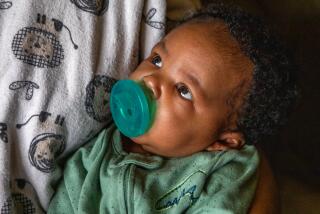Rub Babies the Right Way
- Share via
Babies who need to relax after a long, hard day of eating, sleeping and crying can now unwind the same way adults do: by enjoying a soothing massage.
“A lot of people ask, ‘Why do babies need massage? They don’t go to work, they don’t have to worry about paying bills, they’re not stressed out,’ ” says Cindy Charleton, a registered nurse and certified infant-massage instructor from Huntington Beach. “But infants need tactile stimulation, and this encourages parents to touch their baby.”
For three Thursday mornings a month, Charleton shows parents how to massage newborns to 4-month-olds at the South Orange County Family Resource Center in Mission Viejo.
With their babies propped on pillows, the parents try, with varying degrees of success, to copy the massage techniques that Charleton demonstrates on a doll.
The parents stroke their babies’ faces, lightly knead and press tummies and gently cross and uncross legs and arms. They work from head to toe, massaging with a light touch.
“Once you see these little guys get a massage, you know that babies enjoy it,” Charleton says.
During a recent session, Rancho Santa Margarita resident Kristen Davis places her 6-week-old son, Trevor, on his stomach and gingerly attempts to massage along the sides of his spine as Charleton instructs.
“I can’t even find his spine,” Davis jokes.
*
The babies respond to their parents’ efforts by smiling, stretching, sleeping or crying their heads off (a sign to stop the massage until another time). Trevor thoroughly enjoys the session. His eyelids droop while Davis softly taps her fingers on his tummy. Then he spits up.
“At home he really relaxes. He kicks his legs out, stretches and closes his eyes,” Davis says. In addition to helping Trevor relax, massage has helped him put on pounds, she says.
“He was a preemie and he’s put on tremendous weight. He’s added 4 pounds in six weeks.”
Karen Rinehart of Trabuco Canyon has been massaging her 3-month-old daughter, Paige, after her baths.
“It’s real enjoyable for me to interact with her, and she seems to like it--when she’s in the mood,” Rinehart says.
The class gave Rinehart confidence when handling tiny Paige, who weighed 4 pounds, 12 ounces when she was born.
“In the beginning I was afraid I’d hurt her, but I’ve learned that babies are tougher than we think,” she says.
*
Studies have identified many benefits of infant massage. Recent research has shown that premature babies who were massaged daily gained 47% more weight than those who were not, according to the University of Miami Touch Research Institute. Touch therapy also helps improve infants’ circulation and digestive systems, and helps them sleep better, Charleton says.
At Children’s Hospital of Orange County in Orange, touch is considered so crucial to babies’ well-being that, inside the neonatal intensive care unit, specially appointed “cuddlers” are in charge of holding, rocking and caressing newborns.
“Touch is very important for babies. It helps control their temperature and their heart rate calms down. They gain weight quicker,” says Liz Drake, neonatal nurse practitioner at the hospital. “The babies settle down--you can see their tiny hands relax. It’s kind of miraculous.”
Charleton, whose classes are based on the International Assn. of Infant Massage, tells parents they can massage their baby once or twice a day as long as the baby’s willing.
She teaches them to watch for grimaces and other signs that their baby is not in the mood for a massage. Parents can also continue to offer massages to children as they grow, even if it’s just a back rub after softball practice.
(BEGIN TEXT OF INFOBOX / INFOGRAPHIC)
Infant Massage Tips
Do not begin while baby is crying, hungry or has a full stomach. In the beginning, massage time may last only five minutes. First, warm your hands by rubbing them together. Touch should be gentle, slow and rhythmic. Always be alert to signs of discomfort or distress.
* Head: Stroke in a smooth, circular motion to let baby know it’s massage time.
* Legs: Using both hands, gently stroking down the leg starting at the hip. Repeat on other leg.
* Arms: Stroke from shoulder to wrist.
* Stomach: Make a circle moving only in a clockwise direction.
* Back: Turn your baby over. Start near the neck, making small circles down the length of the back. Avoid massaging directly over the spine.
* Check response: Throughout, watch for signs that your baby is enjoying or not enjoying the routine. Always stop if not.
Source: Cindy Charleton
More to Read
Sign up for Essential California
The most important California stories and recommendations in your inbox every morning.
You may occasionally receive promotional content from the Los Angeles Times.









